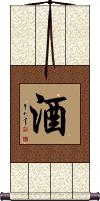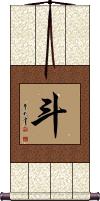Many custom options...
And formats...

Sake in Chinese / Japanese...
Buy a Sake calligraphy wall scroll here!
Personalize your custom “Sake” project by clicking the button next to your favorite “Sake” title below...
Wine / Alcohol / Sake
酒 is the Chinese character, Korean Hanja, and Japanese Kanji which means alcohol.
This can refer to wine (esp. rice wine), liquor, spirits, sake, or to alcoholic beverages in general.
In the west, we tend to say “sake” to mean Japanese rice wine, however, this character is a little ambiguous in Japanese. It literally just means alcohol and is often pronounced “shu” in Japanese. Specifically, in Japanese, you might want to ask for “seishu” or 清酒 to get the sake that you are used to in the west. Seishu literally means “clear alcohol.”
Fight / Beat Someone
斗 is how to express the act of fighting in Chinese.
Generally, this means fighting against someone or some force whether physically or metaphorically.
Note: There is more than one way to write this character. You will notice variations on the next page after you click “Select and Customize.” If you have a preference, please let us know when you place your order.
Please note that there is a secondary pronunciation and meaning of this character. It can also mean “measuring cup” or in Japanese “sake dipper” or even “The Big Dipper.” In Japanese and Korean, this does not have the fighting meaning associated with it. You should, therefore, select this character only if your audience is Chinese, or you are a big fan of sake dippers or The Big Dipper (as that is how it will be read by Japanese and Korean people).
Having High Principles
Do not bow down for the sake of five pecks of rice
不为五斗米折腰 is a Chinese idiom/proverb that speaks of being above bribes and not losing face or honor for short-term gain.
Some may also translate the perceived meaning as “high-hearted” or “integrity beyond reproach.”
The more literal meaning is “Do not bow down for the sake of five pecks of rice.”
Wine
葡萄酒 is the Chinese, Japanese Kanji, and old Korean Hanja for wine.
Very specifically, this is for grape wine (an important distinction in Asia where most wines were rice-based until western influences came into play).
The first word, 葡萄 literally means grape (or grapevine), and 酒 means alcohol (generic term for alcohol, sake, wine, liquor).
Not the results for sake that you were looking for?
Below are some entries from our dictionary that may match your sake search...
| Characters If shown, 2nd row is Simp. Chinese |
Pronunciation Romanization |
Simple Dictionary Definition |
冷 see styles |
lěng leng3 leng rei / re れい |
More info & calligraphy: Cold(1) (abbreviation) (on floor plans) (See 冷蔵庫) refrigerator; (noun or adjectival noun) (2) (rare) cold; cool; (3) (abbreviation) (rare) (See 冷酒・れいしゅ) cold sake; (surname, given name) Rei Cold. |
梟 枭 see styles |
xiāo xiao1 hsiao fukurou; fukuro; sake; fukurou / fukuro; fukuro; sake; fukuro ふくろう; ふくろ; さけ; フクロウ |
More info & calligraphy: Owl(kana only) owl (esp. the Ural owl, Strix uralensis) owl |
カス see styles |
gasu ガス |
More info & calligraphy: Kath |
白鶴 白鹤 see styles |
bái hè bai2 he4 pai ho hakutsuru はくつる |
More info & calligraphy: White Crane(company) Hakutsuru (brand of sake); (c) Hakutsuru (brand of sake) |
聖人 圣人 see styles |
shèng rén sheng4 ren2 sheng jen seijin / sejin せいじん |
More info & calligraphy: Holy Man / Saint(1) {Christn} saint; (2) (orig. meaning) wise and virtuous person (esp. in Confucianism); great religious teacher; sage; (3) (See 清酒) refined sake; (male given name) Masato is the opposite of the 凡人 common, or unenlightened man. |
卮 see styles |
zhī zhi1 chih shi し sakazuki さかづき |
goblet zhi (large bowl-shaped ancient Chinese cup with two handles); sake cup; cup for alcoholic beverages |
坏 see styles |
tsuki つき sakazuki さかづき |
(archaism) shallow bowl; sake cup; cup for alcoholic beverages |
巵 卮 see styles |
zhī zhi1 chih shi し sakazuki さかづき |
old variant of 卮[zhi1] zhi (large bowl-shaped ancient Chinese cup with two handles); sake cup; cup for alcoholic beverages |
提 see styles |
tí ti2 t`i ti hisage ひさげ |
to carry (hanging down from the hand); to lift; to put forward; to mention; to raise (an issue); upwards character stroke; lifting brush stroke (in painting); scoop for measuring liquid (kana only) ceremonial sake decanter with a spout and semicircular handle; (place-name) Hisage To raise, mention, bring forward, summon, lead. |
滓 see styles |
zǐ zi3 tzu kasu かす |
(bound form) dregs; sediment (1) (kana only) dregs; sediment; grounds; meal; (2) (kana only) lees (esp. sake); (3) (kana only) leftovers; by-product; (4) (kana only) worthless item; thing of little to no value; (5) (kana only) dregs (e.g. of society); scum; dross; (6) (kana only) card only worth 1 point (in hanafuda) |
燗 see styles |
làn lan4 lan kan かん |
old variant of 爛|烂[lan4] warming up sake; warmed sake; (female given name) Miyabi |
爲 为 see styles |
wèi wei4 wei tame ため |
variant of 為|为[wei4] (out-dated kanji) (1) (kana only) good; advantage; benefit; welfare; (2) (kana only) sake; purpose; objective; aim; (3) (kana only) consequence; result; effect; (4) (kana only) affecting; regarding; concerning; (surname) Tame To do; to make; to effect; to be; because of; for. |
甑 see styles |
zèng zeng4 tseng koshiki; sou / koshiki; so こしき; そう |
cauldron; rice pot (1) (See 蒸篭・1) steaming basket (traditionally clay or wood); (2) (こしき only) steaming vat (for steaming rice in sake production); (surname) Koshiki |
盃 杯 see styles |
bēi bei1 pei sakazuki さかづき |
variant of 杯[bei1]; trophy cup; classifier for certain containers of liquids: glass, cup (1) sake cup; cup for alcoholic beverages; (suf,ctr) (2) counter for cupfuls; (3) counter for ships, octopuses and squid; sake cup; cup for alcoholic beverages; (place-name) Sakazuki |
盞 盏 see styles |
zhǎn zhan3 chan sakazuki さかづき uki さかずき |
a small cup; classifier for lamps sake cup; cup for alcoholic beverages |
粕 see styles |
pò po4 p`o po kasu かす |
grains in distilled liquor (1) (kana only) dregs; sediment; grounds; meal; (2) (kana only) lees (esp. sake); (3) (kana only) leftovers; by-product; (4) (kana only) worthless item; thing of little to no value; (5) (kana only) dregs (e.g. of society); scum; dross; (6) (kana only) card only worth 1 point (in hanafuda); (surname) Kasu |
糀 see styles |
kouji / koji こうじ |
mould grown on rice, barley, beans, etc. as a starter to make sake, miso, soy sauce, etc. (mold); malted rice; malt; (surname) Kōji |
糟 see styles |
zāo zao1 tsao kasu かす |
dregs; draff; pickled in wine; rotten; messy; ruined (1) (kana only) dregs; sediment; grounds; meal; (2) (kana only) lees (esp. sake); (3) (kana only) leftovers; by-product; (4) (kana only) worthless item; thing of little to no value; (5) (kana only) dregs (e.g. of society); scum; dross; (6) (kana only) card only worth 1 point (in hanafuda); (surname) Kasu |
袴 裤 see styles |
kù ku4 k`u ku hakama はかま |
variant of 褲|裤[ku4] (1) hakama; pleated skirt or loose-legged trousers worn over a kimono mainly on ceremonial occasions; (2) (leaf) sheath; (3) (sake bottle) stand; (surname) Hakama |
觚 see styles |
gū gu1 ku sakazuki さかづき |
goblet; rule; law sake cup; cup for alcoholic beverages |
觴 觞 see styles |
shāng shang1 shang sakazuki さかづき |
feast; goblet sake cup; cup for alcoholic beverages |
醇 see styles |
chún chun2 ch`un chun jun じゅん |
alcohol; wine with high alcohol content; rich; pure; good wine; sterols (1) (obsolete) pure sake; full-bodied sake; (adjectival noun) (2) (obsolete) pure; (given name) Jun |
醪 see styles |
láo lao2 lao moromi もろみ mosoro もそろ |
wine or liquor with sediment (1) (kana only) main fermenting mash (in production of sake or soy sauce); unrefined sake or soy sauce; (can act as adjective) (2) (kana only) unrefined (sake, soy sauce, etc.); rough; (archaism) weak sake; unrefined sake |
醴 see styles |
lǐ li3 li amasake あまさけ |
sweet wine (food term) sweet half sake; sweet drink made from fermented rice; (place-name) Amasake |
鮭 鲑 see styles |
guī gui1 kuei sake(p); shake; sake(p); shake さけ(P); しゃけ; サケ(P); シャケ |
trout; salmon (1) salmon (Salmonidae spp.); (2) chum salmon (Oncorhynchus keta) |
麹 see styles |
kouji / koji こうじ |
mould grown on rice, barley, beans, etc. as a starter to make sake, miso, soy sauce, etc. (mold); malted rice; malt; (out-dated or obsolete kana usage) mould grown on rice, barley, beans, etc. as a starter to make sake, miso, soy sauce, etc. (mold); malted rice; malt; (surname) Kōji |
お酒 see styles |
osake おさけ |
(polite language) alcohol; sake |
サケ see styles |
sake サケ |
(1) salmon (Salmonidae spp.); (2) chum salmon (Oncorhynchus keta) |
どぶ see styles |
dobu どぶ |
(abbreviation) (See 濁酒・どぶろく) unrefined sake; (personal name) Toff |
一献 see styles |
ikkon いっこん |
(1) one cup (of sake); (2) (going out for, treating someone to) a drink; small drinking party |
Click here for more sake results from our dictionary
The following table may be helpful for those studying Chinese or Japanese...
| Title | Characters | Romaji (Romanized Japanese) | Various forms of Romanized Chinese | |
| Wine Alcohol Sake | 酒 | sake / shu | jiǔ / jiu3 / jiu | chiu |
| Fight Beat Someone | 斗 | dòu / dou4 / dou | tou | |
| Having High Principles | 不為五斗米折腰 不为五斗米折腰 | bù wèi wǔ dǒu mǐ zhé yāo bu4 wei4 wu3 dou3 mi3 zhe2 yao1 bu wei wu dou mi zhe yao buweiwudoumizheyao | pu wei wu tou mi che yao puweiwutoumicheyao |
|
| Wine | 葡萄酒 | bu dou shu / bu dou sake budoushu / budousake bu do shu / bu do sake | pú tao jiǔ pu2 tao5 jiu3 pu tao jiu putaojiu | p`u t`ao chiu putaochiu pu tao chiu |
| In some entries above you will see that characters have different versions above and below a line. In these cases, the characters above the line are Traditional Chinese, while the ones below are Simplified Chinese. | ||||
Successful Chinese Character and Japanese Kanji calligraphy searches within the last few hours...







